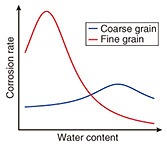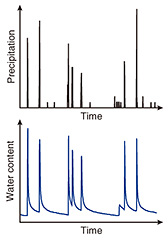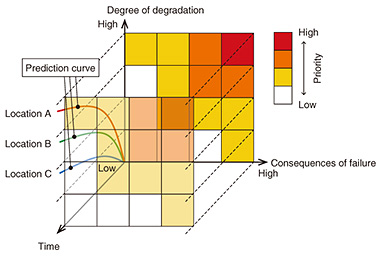 |
|||||||||||
|
|
|||||||||||
|
Feature Articles: Research and Development of Life-cycle Maintenance of Telecommunication Infrastructure Vol. 16, No. 1, pp. 32–38, Jan. 2018. https://doi.org/10.53829/ntr201801fa4 Risk Assessment of Outdoor Telecommunication Facilities Based on Deterioration MechanismsAbstractDealing with the daunting challenges of aging infrastructure will require an efficient long-term maintenance plan for prioritizing the vast backlog of equipment and facilities that need to be upgraded or replaced in the future. To this end, NTT Device Technology Laboratories has introduced the concept of risk as a key indicator for prioritizing maintenance work on telecom infrastructure facilities. We describe here recent work in applying this approach to a basic piece of telecom-related hardware—buried anchors used to stabilize utility poles. Keywords: deterioration mechanism, risk assessment, soil corrosion 1. IntroductionMuch of Japan’s public infrastructure, including roads and highways, water and sewer systems, the electrical power grid, and communications networks, was built up during the period of high economic growth through the 1970s, and there is now an enormous backlog of aging infrastructure projects to deal with. Strained budgets for operations and maintenance, and a reduced maintenance workforce make this even more of a challenge. The prospects for maintaining and managing infrastructure are dire, and there is growing concern that our ability to guarantee the safety and security of the nation’s infrastructure is beyond our capabilities. The NTT Group faces the same challenge with its own enormous telecom-related infrastructure. NTT owns and operates a vast array of telecommunication equipment and facilities of all kinds, and these facilities are not only deployed in built-up urban areas. Quite to the contrary, NTT’s facilities are scattered from one end of the country to the other in every kind of terrain and environment from rugged mountainous landscapes to coastal districts, from geothermal hot spring areas to frigid cold regions, and from underground settings to underwater environments, and the modes and rates of deterioration all vary for the different environments. Proper maintenance of this enormous and diverse telecom infrastructure requires a long-term and methodical maintenance plan based on regular inspections and a clear grasp of the current and predicted states of deterioration of facilities. Essentially, this maintenance plan must prioritize what measures should be taken to upgrade which facilities, and when these measures should be implemented. The basic key here is a prioritization index. For the purposes of deterioration assessment, NTT Device Technology Laboratories has adopted the concept of risk for the basic prioritization index, and we continue to investigate technologies for assessing risk. This article will discuss the concept of risk in relation to buried anchors, a type of buried steel structure used extensively in the telecom industry to support utility poles. 2. Risk assessment trendsThe petroleum refinery industry has been at the forefront of efforts to improve plant management based on the concept of risk. In contrast to the older time-based maintenance approach, the new emphasis on risk is known as risk-based inspection / risk-based maintenance (RBI/RBM). In this context, risk is defined as: Risk = likelihood of failure × consequences of failure As illustrated in Fig. 1, risk calculation results can be presented as a risk matrix taking the likelihood of failure and the consequences of failure as the vertical and horizontal axes of the matrix. Such a matrix is extremely useful because it enables one to immediately see where a piece of equipment falls on the risk spectrum based on the cell position (with increased risk as the equipment migrates toward the red cell at the upper right). It can then be decided whether the risk level is tolerable (or not) and what remedial measures should be taken.
The American Petroleum Institute [1], the American Society of Mechanical Engineers [2], and other organizations have published guidelines for using RBI/RBM planning methods. In 2010, the High Pressure Institute of Japan also published RBI/RBM-related guidelines for dealing with pressure equipment and other machinery specific to that industry [3]. These guidelines are fine for centralized plant equipment in which the usage environments and deterioration mechanisms are relatively well known and considerable data has already been amassed, but they are less useful for the extremely diverse telecom infrastructure facilities that are widely deployed in many different environments. 3. Risk assessment of buried anchorsA schematic diagram of the buried anchor that is the focus of this work is shown in Fig. 2. Buried anchors are embedded in the ground and used to support utility poles. As one can see in the figure, the part consists of two steel plates—a resistance plate and a stabilization plate—that provide support for the pole. There are over ten million of these anchors deployed across Japan, and having an efficient maintenance plan for them is critically important, just as it is with the rest of the company’s infrastructure.
A risk assessment of a buried anchor essentially involves estimating whether the degree of deterioration of the anchor indicates a likelihood of failure, and whether uplifting or pulling out of the anchor could be a consequence of failure, or to express it more parsimoniously: Risk = degree of degradation × consequences of failure The degree of degradation will vary depending on the deployment site. To assess the risk of a particular piece of equipment or an anchor, one must predict the degree of degradation of that part for a particular installation environment. The obvious drawback here is that we cannot make a direct visual inspection since anchors are buried underground, and this makes it exceedingly difficult to gage the degree of degradation. Nor do we have a database of past assessment information, so we are unable to make a statistical estimate of the degree of degradation. Indeed, this is the crux of the problem: the difficulty in assessing the risk of a steel structure (such as an anchor) buried underground, compounded by a lack of data that might help in estimating the degree of degradation. As a way around this predicament, we have attempted to analyze the mechanisms of buried anchor degradation from the standpoint of materials science and then build a theoretical model to estimate the degree of degradation. 4. Mechanisms of soil corrosionThe primary mechanism of anchor deterioration is soil corrosion (corrosion of buried metal caused by soil) as illustrated schematically in Fig. 3. One will observe in the figure that soil corrosion occurs at the interface where metal (steel in this case) comes in contact with soil, and the corrosion causes the thickness of the metal to gradually diminish; in other words, the metal becomes thinner. A photograph of an anchor recently unearthed after being buried in the ground for over 40 years is shown in Fig. 4. One can see that the surface of the part is completely covered with ruddy-colored rust. We used an acidic solution to remove the rust and then measured the thickness of the metal. We found that it was significantly thinner than the original anchor that was put into the ground. If the thickness of the steel is reduced by soil corrosion, then the supporting force provided by the anchor for the utility pole is reduced by a corresponding degree. Predicting the degree of deterioration of a buried anchor can thus be equated to predicting the degree of steel thinning caused by soil corrosion.
Aside from buried anchors, the corrosion of buried water pipes and gas lines is highly problematic and has been extensively studied throughout the world. The American National Standards Institute (ANSI) in particular has drafted soil corrosivity standards [4]. The ANSI standards are widely used in Japan for their effectiveness in evaluating the corrosivity of soils. However, a drawback of these standards is that the relationship between the criteria for evaluation and corrosivity is left as a qualitative expression [5]. In the field of soil corrosion, there are many outstanding issues, and it is difficult to say whether quantitative knowledge has been systematized. This is because so many external factors (environmental factors) affect corrosion and interact in ways that make soil corrosion very complex. Given these circumstances, to predict the degree of steel plate thinning caused by soil corrosion, we have to: (1) define environmental factors that predominantly contribute to soil corrosion, (2) quantitatively determine how environmental factors affect the corrosion rate, and (3) figure out how to gather data about environmental factors at actual soil sites. By addressing these three issues, we should be able to figure out the corrosion rate from information about the environmental factors, and this would enable us to theoretically calculate the amount of thinning of a steel plate buried for any elapsed period of time. We are now conducting trials to measure electrochemical corrosion in simulated soils in the laboratory and to monitor outdoor soils. These experiments are explained in the following sections. 5. Electrochemical corrosion in simulated soil trialTo develop a theoretical model to derive the corrosion rate from information on environmental factors, we constructed a simulated soil testing apparatus in the lab to measure the electrochemical corrosion rate of a steel plate. A schematic diagram and a photograph of the testing apparatus are shown in Fig. 5. As can be seen in the figure, the apparatus regulates water supply and drainage to simulate rainfall, while controlling the temperature of the soil in a temperature-controlled chamber. Soil corrosion occurs on the surface of the steel plate through the following chemical reactions: Anode reaction: Fe → Fe2+ + 2e− Cathode reaction: O2 + 2H2O + 4e− → 4OH−
The corrosion rate can be evaluated by measuring the reaction resistance—an index of how readily the corrosion reaction occurs—and then taking the reciprocal. Various resistance components (electrical resistance of soil, water, etc.) are mixed together in the soil, so in conducting the measurement we employed the alternating current impedance method, which enables us to isolate only the reaction resistance using the frequency band. The soil environment involves three phases. In the first phase, soil particles are in a solid stage. In the second and third phases, water and air exist respectively in the gaps between soil particles. As is evident from the chemical reactions cited above, water and air (i.e., oxygen) are essential for soil corrosion to occur. We can thus assume that wetting on the surface of the buried steel plate and the ratio of water and air (water content) of the soil strongly affect the corrosion rate. We have thus hypothesized that the primary environmental factors involved in soil corrosion are the soil particle size distribution and water content, which determine the steel plate surface wetting, and the ratios of water and air in soil, and we are now pursuing experiments to corroborate this hypothesis. We measured the corrosion rate for different levels of water content in two kinds of soil—one composed of small-size particles and the other of coarser particles—and obtained the interesting findings presented in Fig. 6. One can see that the corrosion rate does not change monotonically with the water content, but rather peaks at a certain water content level. We also found that the water content for the corrosion peak varied widely depending on the particle size distribution of the soil.
These findings suggest that the conventional qualitative wisdom that corrosion increases as the water content in the soil increases (i.e., a high corrosion rate), such as manifested in the ANSI evaluation criteria, may be incorrect. Indeed, we believe that one factor that has never been considered as a predictor of soil corrosion in conventional assessment standards is the nonlinear nature of soil corrosion with respect to the water content. In other words, by identifying the relationship between water content for different distributions of soil particle size and the corrosion rate, we should be able to derive the corrosion rate from the water content and soil particle size distribution, and this would enable us to calculate the amount of corrosion. We are already planning more detailed studies to explore the quantitative interrelations among soil particle size, water content, and the corrosion rate. 6. Outdoor soil monitoring trialIn line with our third objective—how to gather environmental factor data in actual soil settings—we are conducting environmental factor monitoring trials to gain a better understanding of actual soil environments. The soil at the test site is a typical Kanto loam, a soil with roughly equal proportions of sand, silt, and clay distributed throughout Tokyo and its surrounding areas. Anchors are typically buried at a depth of 1.5 m, so for these trials we dug holes slightly less than 2 m deep, placed sensor equipment in them, backfilled the holes, and then measured the changing environmental factors over time. The change in water content over time at a depth of 1.6 m as a function of the amount of precipitation (amount of rainfall per hour) is shown in Fig. 7. For the amount of precipitation, we employed data from the local meteorological observation station closest to the test site. The water content of the soil closely mirrored the amount of rainfall, and we observed a regular cycle: the water content sharply increased when it rained, then drained and dissipated in much the same way each time as soon as the rain stopped.
This suggests that the water content of the soil can be calculated with some degree of accuracy based on weather information if the drainage rate for the particular soil is known. Certain information is needed to predict the amount of metal thinning over time—namely, the water content of the soil and the type and distribution of its particle size—but we think this scheme could be implemented using soil classification maps commissioned by national or local governments. 7. Future developmentThis article described some of our recent efforts to estimate and assess risk in a case study involving buried anchors, which are steel structures embedded in the ground to support utility poles. The risk matrix concept that we are trying to achieve is depicted in Fig. 8. As one can see, this figure includes a time axis along with axes for the degree of degradation and consequences of failure, and priority is represented by colors ranging from white (low priority) to red (urgent priority) as we saw earlier in Fig. 1. The progress of deterioration varies depending on the installation environment as we noted earlier, so naturally, the urgency or priority of the work will also vary along the time axis. Due to our better understanding of soil corrosion mechanisms plus publicly available data (weather reports and soil classification maps), we are getting closer to developing a theoretical model that can predict the degree of degradation of underground anchors after a certain amount of time has elapsed.
Regarding the consequences of failure, in the case of buried anchors, this might mean that the anchor pulls out, which would cause the utility pole to topple over and adversely affect the surrounding area. To assess the consequences of failure in the event that a utility pole collapses or falls over, our research group has already investigated this set of circumstances, so we were able to reference this earlier work in the present study. With the risk matrix that we developed through this study, we plan to build a prioritization index that will contribute to the development of more efficient maintenance plans. The challenge of replacing aging infrastructure is certainly not confined to telecom-related equipment and facilities but is a critical issue affecting the entire country. We remain committed to the development and deployment of useful technology that will achieve a safer, more secure, and a better society in the years ahead. References
|
|||||||||||























